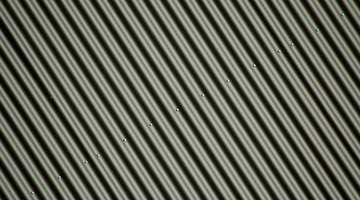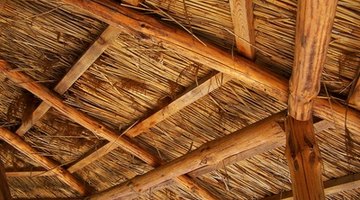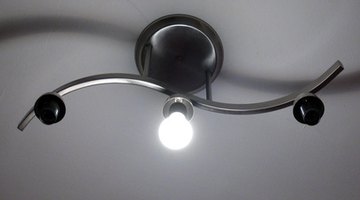How to Install Corrugated Metal Roofing on Ceilings
Corrugated metal ceilings are popping up across the country thanks to the growing popularity of green building and the interest in Latin American and Southwestern European cultures. In the U.S.

, they are installed for aesthetics, to achieve an Old World look from places that have used and still use corrugated metal roofs, to protect dwelling inhabitants from the elements, and on green building projects. It is an inexpensive, easy and effective style of roofing in many growing nations as well a developed nations. Installing corrugated metal roofing panels on the ceiling is a reminder of where we've been historically and where we are headed in the future.
Things You Will Need
- Corrugated metal panels
- 1 inch to 1 1/2 inch screws
- 1/2 inch metal to metal screws
- Tape measure
- Ruler
- Protective eye wear
- Protective gloves
- Hardhat
- Drill
- Metal sheers or snips
- Scaffolding or multi-purpose ladder
Tip
Measure twice, cut once. Always check with your local building department for specific codes in your area before beginning any building project.
Warning
Use your safety equipment consistently.
Practice safety while on scaffolding and ladders.
Have a set of helping hands present to assist you. This is not a project that should be done alone.
-
Determine the material your ceiling beams are made of so you know what type of screws to use. If the beams are made of wood, you should use wood screws. For metal, you should use self-tapping screws. For concrete, tap con screws are best, but both the panels and beams will have to be pre-drilled for these. Be sure to use neoprene washers for each screw. Hex-head fasteners are recommended for use with all of these materials.
-
Measure the ceiling to determine the square footage. Square footage is determined by multiplying the length and width of an area. For example, if the ceiling is 10 feet by 12 feet, the square footage is 120 square feet. Once you have this calculation, you can determine how many panels and hardware you need. Depending on your design, add inches or feet to your calculations for any panels that will overlap. Take your calculations with you to your supplier, as they are usually happy to help with "do it yourself" projects.
-
Place the panels on the ceiling in the exact place where you'd like them affixed. Plan the installation to begin at the farthest point from the most visible area of the room, for example, a far corner away from doorways. Take note of the fixtures on the ceiling and trace lines where holes will have to be cut from your corrugated metal to accommodate these fixtures. Be precise so you don't make mistakes that could cost you a panel. The holes should be cut while you and the panels are safely on the ground.
-
Cut out the tracings you have made on the panels for your ceiling fixtures by punching holes well inside the trace lines using a drill. Use these holes to make your initial cuts into the metal using the metal sheers. Continue to make small and careful cuts, working your way out to the trace lines. Work slowly as these cuts should be precise.
-
Drill the screws into the corrugated metal panels onto the beams every 12 inches. The screws should be fastened at least 1 inch deep into the beams. Ideally, the wood beams will be located every 2 feet, or 6 feet apart for steel beams. Continue this process until all the panels are safely affixed to the ceiling.
-
Use 1/2-inch metal-to-metal screws to seal the seams of the overlapping panels. Their distance depends on your design and preference, as keeping wind and rain out is not a concern in this case. If you'd like the ceiling to look rustic, leave large gaps between the screws. If your goal is a clean-cut look, seal the seams closer together, using the same measurements between screws.





The Drip Cap
- Corrugated metal ceilings are popping up across the country thanks to the growing popularity of green building and the interest in Latin American and Southwestern European cultures.
- In the U.S., they are installed for aesthetics, to achieve an Old World look from places that have used and still use corrugated metal roofs, to protect dwelling inhabitants from the elements, and on green building projects.
- If the beams are made of wood, you should use wood screws.
- Depending on your design, add inches or feet to your calculations for any panels that will overlap.
- Use these holes to make your initial cuts into the metal using the metal sheers.
- Use 1/2-inch metal-to-metal screws to seal the seams of the overlapping panels.
- If you'd like the ceiling to look rustic, leave large gaps between the screws.
References
- Anthony Tolerico, President, BLUEGREEN ROOFING, Inc.
Writer Bio
Sheila Tolerico holds a degree in fashion marketing and management. Tolerico has been studying holistic health and nutrition for four years, and is about to begin formal training in those fields. She is bilingual in English and Spanish, and has basic fluidity in Portuguese and Italian. Tolerico writes on eHow and for Textbroker.com, where she maintains a 4-star rating.
Photo Credits
- hintergrund wellblech image by Otmar Smit from Fotolia.com
- hintergrund wellblech image by Otmar Smit from Fotolia.com
- a cane roof image by Alex White from Fotolia.com
- tape image by Rog999 from Fotolia.com
- ceiling light view2 image by askthegeek from Fotolia.com
- drill image by Vladislav Gajic from Fotolia.com
- riveted seam on the metal scratched sheet image by Anatoly Tiplyashin from Fotolia.com
More Articles



